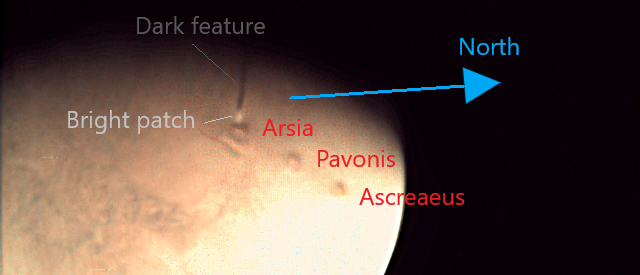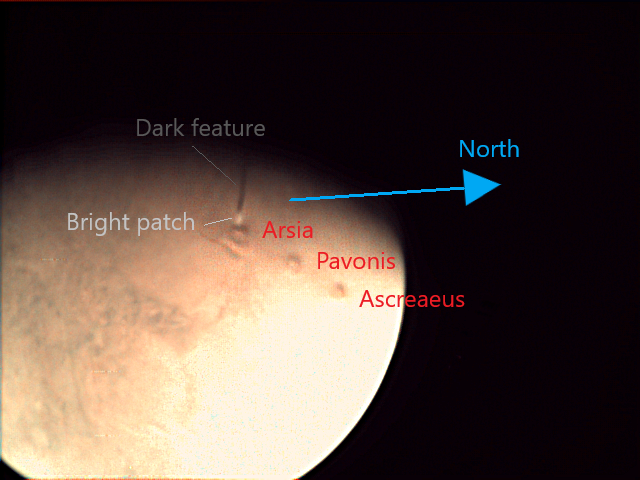Is that a Plume on Arsia Mons?

This morning, as I was browsing through a new batch of VMC images, I spotted something that struck me as unusual. The images I was looking at had been taken by the VMC camera on the ESA Mars orbiter Mars Express on Sunday, 23 September 2018, between 12:13:49 and 12:17:08 while the spacecraft was at an altitude of almost 10,000 km above the Eastern Tharsis range.
There are three huge volcanoes that are almost perfectly arranged on a long line that goes from Southwest to Northeast. At the northeastern end, you have Ascraeus Mons, in the middle, amost exactly on the Mars equator, Pavonis Mons and at the southwestern end there is Arsia Mons, easily recognisable by its enormous caldera, which is open at the northeastern end. The terminator was a bit west of these three, so it must have been about two hours after sunrise there.
If you traveled due Northeast from Pavonis Mons, on a course that is perpendicular to the line that connects these three, you’d encounter Olympus Mons, the mightiest volcano in the solar system. But you can’t see it in this image because it’s still night there.
On 23 September 2018, Mars was at a solar longitude of 255 deg, meaning that it is approaching winter solstice … about half a Mars month to go until the start of northern winter and southern summer, and not long after perihelion.
I have put one of the five images in that sequence here with some annotations, and below that I have added a cutout of the area around Arsia Mons that shows the unusual sight which piqued my interest.


First of all, on the western slope of Arsia Mons, there is a sharply delimited bright patch. Continuing west by northwest away from that bright path is an extended dark feature.
One possible explanation might be that the bright patch is a cloud or plume that has an extended vertical component … or in simpler words, it’s tall. The black feature would then simply be the shadow of that cloud or plume on the surface.
The shadow theory would be consistent with the fact that the Sun was still at a relatively low elevation above the local horizon at the time when that image was taken. This means that any large object would cast a very long shadow. Also, judging by the orientation of the terminator the sun would be exactly in the direction of that dark, linear feature, if you extended it downwards … meaning that the sun would be where it would have to be for a shadow to be in that precise direction.
A possible alternative explanation would be an artefact produced by the camera, such as a scratch on the lens or something was was created by the compression algorithm. I know that there are some scratches on the lens that appear on all shots, but they look a lot different from this. Also, the scratches are always in the same location in the image, while this feature stays where it is with respect to Mars and therefore appears to move as you click through the five photos of the sequence. Please try for yourself. As for JPEG artefacts, those don’t look like this.
Assuming for a moment that this is in fact a cloud or a plume. It must be very large and also rather dense if it can cast such a long, dark shadow. But what would cause a towering cloud on Mars? I know that leeward (orographic) clouds have been observed near the Tharsis volcanoes (e.g., here). But are these so delimited and do they have a large vertical extent? I thought that such clouds would tend to fan out in waves, in which case they would not case a thin, long shadow.
So, what else, then? As the bright streak does not appear to be originating from the summit of Arsia Mons, could it be something else? A local dust storm event? But if it were that, and it had already reached such a height, wouldn’t the surface features already be obscured by high altitude dust? That is what happened during the global dust storm earlier this year.
Actually, going back to some images taken earlier this month, I see another dark feature similar to the one above in images taken on 19 September 2018. However, this looks different. The direction is the same, but the bright streak isn’t there. And I don’t see that at all in an image from early September, nor in earlier shots from August.
The fact that this feature, or at least something very similar, appears already 4 days ago is an indication that this can’t be a cloud, nor a storm event. Would such phenomena stay put for so long?
I find this very intriguing. If anyone has ideas, please leave a comment below and share your theories.


Auf Aufnahmen vom 13. September zeigt sich dieses Phänomen besonders eindruckvoll.
Auf den Aufnahmen vom 7. September ist noch nichts erkennbar.
Am 13-09-2018 um 06:12:45 kann man das Phänomen noch deutlich erkennen, aber um 07:50:57 (aus einem anderen Winkel betrachtet) ist höchstens ein dünner schwarzer Strich wahrnehmbar.
Auch am 24. September gut zu sehen.
Have you seen the latest Michael?!
https://www.flickr.com/photos/esa_marswebcam/44207538984/in/faves-146423059@N02/
I’m of course NOT a planetary geologist, but there is SOMETHING going on that merits more attention/observation. That is now an extensive, and amazingly cohesive plume apparently originating from the flank of Arsia Mons.
I naively attempted to contact both ESA & NASA a few days ago. I received an “out of office” reply from the “imagery” inquiry address at the ESA website and the NASA Mars contact vehicle is a joke. I did not call either, since I fully expected that to be even more futile and disappointing.
And I see nothing at all in any press. At least that I’m aware of.
Hallo Michael, hallo Kommentatoren,
eine tolle Beobachtung! Das Phänomen setzt sich nach dem 24.09. fort. Je nach Sonnenstand ist die lange Fahne schräg beleuchtet oder liegt in ihrem eigenen Schatten. Die aufsteigende Front ist hell beleuchtet. Auf den besten Aufnahmen sieht man auch den Schatten der langen Fahne auf dem Boden. Zwischenzeitlich war die Fahne mal weg/nicht sichtbar. Die z.Z. aktuellsten Bilder ähneln wieder der Beobachtung vom 23.09.. Bin schon gespannt, wenn wieder die Planetenseite mit den Vulkanen ins Bildfeld kommt. Ich hatte gehofft, dass es sich um einen Gasaustritt/Ausbruch auf der Flanke des Vulkans handelt, aber nach Wikipedia und andere Internetseiten ist es ein jährlicher zyklonaler Staubsturm vor Beginn des Winters, dessen Spiralwolke 15 – 30 km Höhe erreichen kann. Die Bilder passen super zu dieser Beschreibung. Entstehungsursache soll warme Luft aus der südlichen Marshemisphere sein.
https://de.wikipedia.org/wiki/Arsia_Mons
Die Spiralwolke kommt sogar schon bei Perry Rhodan vor!
https://books.google.de/books?id=4gdwDAAAQBAJ&pg=PT651&lpg=PT651&dq=arsia+mons+spiralwolke&source=bl&ots=PoFKOU-M0x&sig=eiYeS_00mRjcLp5J57YRkXR-stY&hl=de&sa=X&ved=2ahUKEwis1YCLhN3dAhXKIcAKHTt4DOIQ6AEwC3oECAEQAQ#v=onepage&q=arsia%20mons%20spiralwolke&f=false
Hallo Michael, hallo Astro-Fans,
das ist in der Tat ein interessantes Phänomen!
Ich sage zwar nicht, dass es sich auf jeden Fall um eine Wolke oder Schatten derselben handeln muss. Aber man kann schon Vergleiche mit einem ähnlichen Bild ziehen, etwa diesem hier von 2015:
Hallo Michael, hallo Astro-Fans,
das ist in der Tat ein interessantes Phänomen!
Ich sage zwar nicht, dass es sich auf jeden Fall um eine Wolke oder Schatten derselben handeln muss. Aber man kann schon Vergleiche mit einem ähnlichen Bild ziehen, etwa diesem hier von 2015:
http://www.planetary.org/multimedia/space-images/mars/arsia-mons-and-cloud-mars.html
Eine Kompositaufnahme des Mars Global Surveyors von 2005 ist sicherlich interessant in diesem Zusammenhang.
Auch am 16. Oktober immer noch gut zu sehen.
Hi Mike- Secureteam10 just posted all the ESA images proving this is a 1000’s of km long ash plume. NASA imagery of the Arsia Mons area for 9/24 and beyond has been scrubbed of this obvious plume. Imagine my shock. The ESA needs to supply a press release regarding this as the genie is out of the bottle.
Da die Wolke immer noch da ist und letztens wieder mehr davon zu lesen war, habe ich mal ein paar Marsforscher befragt – und eine übereinstimmend eindeutige Antwort bekommen: Es ist eine ausgeprägte aber normale orografische Wolke, wie sie schon seit einem Jahrzehnt besonders häufig bei diesem Vulkan beobachtet wird. Aber Veränderungen in der Marsatmosphäre nach dem großen Staubsturm – und eine besonders günstige VMC-Geometrie – haben sie nun möglicherweise besonders auffällig werden lassen.
@ Ustinov: There will an ESA press release (or at least some news note) shortly discussing the VMC images that continue to show the cloud prominently, I’ve been told by several sources. It’s really just a pretty well-known meteorological phenomenon at that location, albeit worthy of further study and atmospheric circulation modelling, I’m told.
Der ESA Press Release ist heute Nachmittag heraus gekommen: (und in https://abenteuer-astronomie.de/nein-hier-bricht-kein-mars-vulkan-aus/ hatte ich vorgestern noch mal die Erkenntnisse zusammen gefasst).
I have originated a project to learn the source of the white plume-shaped cloud. Please see the link below my email address. In a nutshell, it is proposed to be the sublimation of H2O ice through loose rock on the surface.
Jim Melka
Assistant Mars Coordinator of the Association of Lunar and Planetary Observers
https://sites.google.com/site/trailtopmarsastronomy/home/test-page